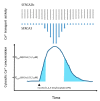Endoplasmic Reticulum Calcium Pumps and Tumor Cell Differentiation
- PMID: 32397400
- PMCID: PMC7247589
- DOI: 10.3390/ijms21093351
Endoplasmic Reticulum Calcium Pumps and Tumor Cell Differentiation
Abstract
Endoplasmic reticulum (ER) calcium homeostasis plays an essential role in cellular calcium signaling, intra-ER protein chaperoning and maturation, as well as in the interaction of the ER with other organelles. Calcium is accumulated in the ER by sarco/endoplasmic reticulum calcium ATPases (SERCA enzymes) that generate by active, ATP-dependent transport, a several thousand-fold calcium ion concentration gradient between the cytosol (low nanomolar) and the ER lumen (high micromolar). SERCA enzymes are coded by three genes that by alternative splicing give rise to several isoforms, which can display isoform-specific calcium transport characteristics. SERCA expression levels and isoenzyme composition vary according to cell type, and this constitutes a mechanism whereby ER calcium homeostasis is adapted to the signaling and metabolic needs of the cell, depending on its phenotype, its state of activation and differentiation. As reviewed here, in several normal epithelial cell types including bronchial, mammary, gastric, colonic and choroid plexus epithelium, as well as in mature cells of hematopoietic origin such as pumps are simultaneously expressed, whereas in corresponding tumors and leukemias SERCA3 expression is selectively down-regulated. SERCA3 expression is restored during the pharmacologically induced differentiation of various cancer and leukemia cell types. SERCA3 is a useful marker for the study of cell differentiation, and the loss of SERCA3 expression constitutes a previously unrecognized example of the remodeling of calcium homeostasis in tumors.
Keywords: SERCA; calcium signaling; cancer; differentiation; endoplasmic reticulum; ion transport; leukemia.
Conflict of interest statement
The authors declare no conflict of interest.
Figures



Similar articles
-
Endoplasmic reticulum calcium pumps and cancer.Biofactors. 2011 May-Jun;37(3):139-49. doi: 10.1002/biof.142. Epub 2011 Jun 14. Biofactors. 2011. PMID: 21674635 Review.
-
Induction of endoplasmic reticulum calcium pump expression during early leukemic B cell differentiation.J Exp Clin Cancer Res. 2017 Jun 26;36(1):87. doi: 10.1186/s13046-017-0556-7. J Exp Clin Cancer Res. 2017. PMID: 28651627 Free PMC article.
-
Expression of endomembrane calcium pumps in colon and gastric cancer cells. Induction of SERCA3 expression during differentiation.J Biol Chem. 2002 Jul 19;277(29):26310-20. doi: 10.1074/jbc.M201747200. Epub 2002 May 1. J Biol Chem. 2002. PMID: 11986315
-
Loss of endoplasmic reticulum calcium pump expression in choroid plexus tumours.Neuropathol Appl Neurobiol. 2014 Oct;40(6):726-35. doi: 10.1111/nan.12098. Neuropathol Appl Neurobiol. 2014. PMID: 24224513
-
[Expression of SERCA pumps during cell differentiation and tumorigenesis: application to colonic carcinogenesis].Ann Pathol. 2006 Jun;26(3):159-72. doi: 10.1016/s0242-6498(06)70701-5. Ann Pathol. 2006. PMID: 17127848 Review. French.
Cited by
-
LINC00998-encoded micropeptide SMIM30 promotes the G1/S transition of cell cycle by regulating cytosolic calcium level.Mol Oncol. 2023 May;17(5):901-916. doi: 10.1002/1878-0261.13358. Epub 2022 Dec 29. Mol Oncol. 2023. PMID: 36495128 Free PMC article.
-
A novel gene signature based on endoplasmic reticulum stress for predicting prognosis in hepatocellular carcinoma.Transl Cancer Res. 2024 Sep 30;13(9):4574-4592. doi: 10.21037/tcr-24-191. Epub 2024 Sep 18. Transl Cancer Res. 2024. PMID: 39430815 Free PMC article.
-
The Meeting of Micropeptides with Major Ca2+ Pumps in Inner Membranes-Consideration of a New Player, SERCA1b.Membranes (Basel). 2023 Feb 25;13(3):274. doi: 10.3390/membranes13030274. Membranes (Basel). 2023. PMID: 36984661 Free PMC article. Review.
-
Nano-Based Drug Delivery of Polyphenolic Compounds for Cancer Treatment: Progress, Opportunities, and Challenges.Pharmaceuticals (Basel). 2023 Jan 10;16(1):101. doi: 10.3390/ph16010101. Pharmaceuticals (Basel). 2023. PMID: 36678599 Free PMC article. Review.
-
Integrated analysis identifies oxidative stress genes associated with progression and prognosis in gastric cancer.Sci Rep. 2021 Feb 8;11(1):3292. doi: 10.1038/s41598-021-82976-w. Sci Rep. 2021. PMID: 33558567 Free PMC article.
References
-
- Lopez J.J., Jardin I., Albarrán L., Sanchez-Collado J., Cantonero C., Salido G.M., Smani T., Rosado J.A. Advances in Experimental Medicine and Biology. Vol. 1131. Springer; Berlin/Heidelberg, Germany: 2020. Molecular Basis and Regulation of Store-Operated Calcium Entry; pp. 445–469. - PubMed
Publication types
MeSH terms
Substances
Grants and funding
LinkOut - more resources
Full Text Sources
Medical
Research Materials

